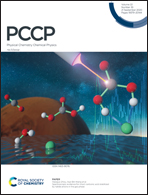Cooperative protein–solvent tuning of proton transfer energetics: carbonic anhydrase as a case study†
Abstract
We investigate the coupling between the proton transfer (PT) energetics and the protein–solvent dynamics using the intra-molecular PT in wild type (wt) human carbonic anhydrase II and its ten-fold faster mutant Y7F/N67Q as a test case. We calculate the energy variation upon PT, and from that we also calculate the PT reaction free energy, making use of a hybrid quantum mechanics/molecular dynamics approach. In agreement with the experimental data, we obtain that the reaction free energy is basically the same in the two systems. Yet, we show that the instantaneous PT energy is on average lower in the mutant possibly contributing to the faster PT rate. Analysis of the contribution to the PT energetics of the solvent and of each protein residue, also not in the vicinity of the active site, provides evidence for electrostatic tuning of the PT energy arising from the combined effect of the solvent and the protein environment. These findings open up a way to the more general task of the rational design of mutants with either enhanced or reduced PT rate.



 Please wait while we load your content...
Please wait while we load your content...